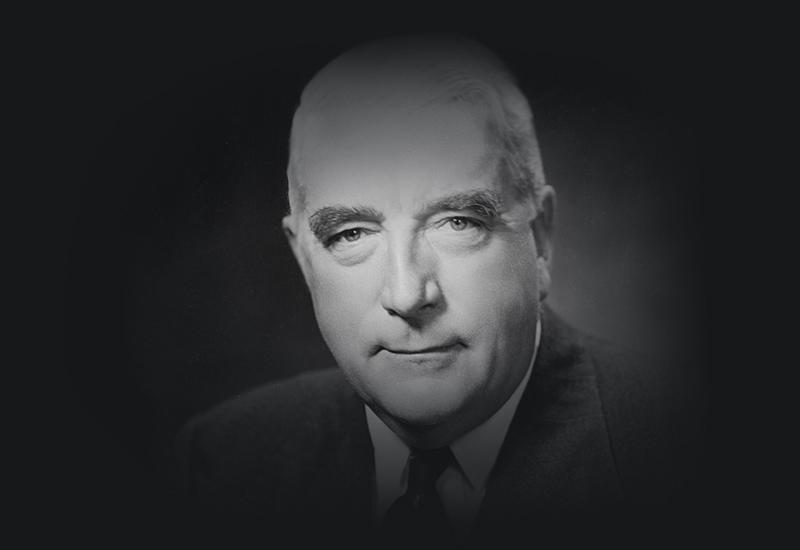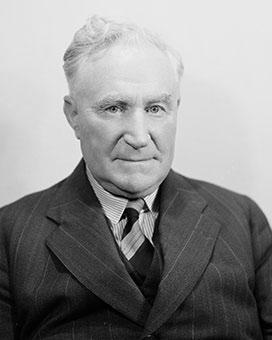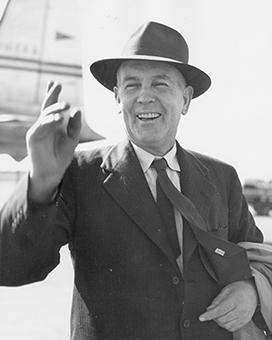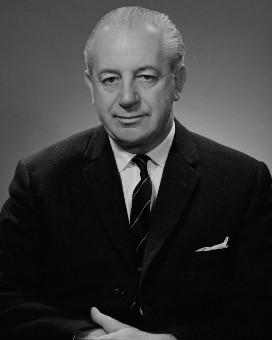On this page
1930 to 1939
15 Sep 1934: First elected to Federal Parliament
Menzies was elected as Member of Parliament for the seat of Kooyong (Vic.), in the 14th federal election.
26 Apr 1939: 12th Prime Minister
Menzies was sworn in as prime minister, after he was elected leader of the United Australia Party.
3 Sep 1939: Australia declares war on Germany
After German troops invaded Poland on 1 September, Britain declared war. The dominions, including Australia, followed with separate declarations the same day.
20 Oct 1939: Compulsory military training
Six weeks after Australia entered the Second World War, Menzies announced the reintroduction of compulsory defence training. It took effect on 1 January 1940. Unmarried men aged 21 were required to undergo 3 months training with the militia.
20 Dec 1939: Australia calling
Radio Australia began broadcasting from Sydney. The station moved to Melbourne the following year.
1940 to 1949
7 Jan 1940: Australia's first diplomats
Australia's first diplomatic post was set up with the despatch of Richard Casey to Washington. On 18 August, John Latham was appointed to Tokyo in the first exchange of diplomats with Japan.
13 Aug 1940: Canberra air disaster
A Lockheed Hudson plane crashed near the Canberra aerodrome, with the loss of all aboard. The passengers included 3 federal ministers and the Chief of the General Staff.
21 Sep 1940: 16th federal election
The United Australia Party-Country Party coalition wins the most seats but not a clear majority. Menzies forms a minority government with the support of 2 independent cross-bench members.
29 Aug 1941: Resignation
Facing considerable criticism from the Opposition and within his own party. Menzies resigned as prime minister and leader of the United Australia Party on 29 August 1941.
22 Sep 1943: UAP leadership
Menzies is re-elected as leader of the United Australia Party after heavy losses at the 17th federal election.
14 Dec 1944: A new party
Menzies played a key role in the formation of the new Liberal Party of Australia. The new party replaced the United Australia Party, which had struggled to secure electoral success against a strong Labor government.
19 Dec 1949: Prime Minister for the 2nd time
Robert Menzies became prime minister for the 2nd time, after the Liberal-Country Party coalition won a convincing victory at the 19th federal election on 10 December. This started a 16-year term that set a record in Australian politics.
27 Dec 1949: Independence for Indonesia
The independent Republic of the United States of Indonesia was established. This ended 5 years of revolution and military struggle with the Netherlander authorities. Nationalist forces had unilaterally declared independence on 17 August 1945 after almost 350 years of Netherlander rule.
1950 to 1959
9 Jan 1950: Colombo Plan
The idea of a network of developing and donor countries was raised at a conference in Colombo, Sri Lanka (then Ceylon). A 5-year scheme started in 1951 and was repeated until 1980. The Colombo Plan then became a permanent resource for development and education in East and South-East Asian countries.
23 Jun 1950: Communist Party ban
The Communist Party Dissolution Bill was passed by parliament. After it was enacted in October, the law was challenged in the High Court and, on 9 March 1951, was held to be unconstitutional. The Court ruled that parliament could not invoke its defence powers to rule an association unlawful when the nation was not at war.
26 Jul 1950: Australia joins Korean War
The government announced Australia would send troops to fight in Korea. This was part of the United Nations response to the invasion of South Korea by North Korea on 25 June. The front line moved into North Korea and the war continued for 3 years.
1 Jan 1951: Commonwealth Jubilee
Celebrations began throughout Australia to mark the 50th anniversary of Federation.
19 Mar 1951: Parliament dissolved
The Governor-General granted a double dissolution of both houses of parliament. He held that the Senate's action in referring the Commonwealth Bank Bill to committee was a 'failure to pass' the Bill. This was only the 2nd double dissolution of the parliament, the 1st being in 1914.
12 Apr 1951: National Service begins
The 1st call-up notice was issued under the National Service Act. The Act provided for compulsory military training of 18-year-old men, who were then to remain on the Reserve of the Commonwealth Military Forces for 5 years. Between 1951 and 1960 when the scheme ended, over 500,000 men had registered, 52 intakes were organised, and some 227,000 men were trained.
28 Apr 1951: 20th federal election
The Liberal-Country Party coalition retained government and gained control of the Senate.
9 Sep 1951: Peace Treaty signed
At San Francisco, 49 nations signed the peace treaty with Japan, agreeing to the binding terms of the war settlement.
22 Sep 1951: Referendum on Communism
A referendum to alter the Constitution so as to grant parliament the power to outlaw Communism was lost narrowly.
6 Feb 1952: Queen Elizabeth II
Elizabeth II was proclaimed Queen after the death of her father, King George VI. The Queen was crowned in Westminster Abbey on 2 June 1953.
29 Apr 1952: ANZUS Treaty
The security treaty between Australia, New Zealand and the United States, signed in Canberra on 1 September 1951, came into force. Aimed at maintaining peace in the Pacific, the ANZUS Treaty endured until 1986. The United States suspended their agreement with New Zealand after the ban on nuclear-powered and nuclear-armed US Navy ships in New Zealand waters.
3 Oct 1952: Montebello atomic tests
The first British atomic tests were held in the Montebello Islands, 120 km nort-west of Dampier, Western Australia. Tests were then moved to Emu Field in north-western South Australia.
8 May 1953: 13th Governor-General
Sir William Slim served as Governor-General until 2 February 1960. Lord Northcote was acting Governor-General from 30 July to 22 October 1956, and Sir Dallas Brooks was acting Governor-General from 8 to 16 January 1959.
27 Jul 1953: Korean War over
The United Nations and North Korea signed the agreement ending 3 years of war on 27 July 1953. Relations between the Republic of Korea in the south and the Democratic People's Republic of Korea in the north remained strained. Australia did not establish diplomatic relations with North Korea until 1974.
3 Feb 1954: The Queen in Australia
Queen Elizabeth arrived in Sydney aboard the royal yacht Gothic. The 1st reigning monarch to visit Australia, the Queen and Prince Phillip covered 10,000 miles (16093 km) by air and 2000 miles (3219 km) on the ground by the time they left Australia on 1 April.
13 Feb 1954: Mawson Station
Australia's 1st permanent station in Antarctica was established. The Kista Dan was used to convey men and materials. Davis, the 2nd station, was established in 1957 as part of Australia's contribution to the International Geophysical Year.
20 Apr 1954: The Petrovs defect
A week after the defection of Vladimir Petrov, Evdokia Petrov also appealed for political asylum in a dramatic scene at Darwin airport. Based on evidence provided by the two Soviet Embassy cipher officers, a Royal Commission on Espionage was held. After the Commission reported in October 1955, the Petrovs became Melbourne suburbanites Sven and Maria Allyson.
29 May 1954: 21st federal election
The Liberal-Country Party coalition retained government despite losing the popular vote to Evatt's Labor Party.
8 Sep 1954: SEATO established
The formation of the Southeast Asia Treaty Organisation, a defence alliance of countries in Southeast Asia and part of the southwest Pacific, was aimed at containing Communism. Australia, Britain, France, New Zealand, Pakistan (until 1973), the Philippines, Thailand and the United States were members. SEATO was disbanded in 1977.
11 Jun 1955: Privilege of Parliament
Newspapermen Frank Browne and Raymond Fitzpatrick were charged in the House of Representatives with breaching parliamentary privilege. In the only such case in the 20th century, they served 3 months in jail on the order of Cabinet.
23 Oct 1955: Cocos (Keeling) Islands on board
The Cocos (Keeling) Islands became Commonwealth territory with the proclamation of the Cocos (Keeling) Island Act. The 27 coral islands in 2 atolls are in the Indian Ocean, some 2800 km north-west of Perth.
10 Dec 1955: 22nd federal election
The Liberal-Country Party coalition retained government and increased its majority.
16 May 1956: Maralinga atomic tests
The 1st nuclear tests took place at Maralinga, South Australia. This was developed as a permanent test site in response to a request from the British government after the 1st tests at Montebello and Emu Field in 1953 and 1954. The tests conducted at Maralinga until 1963 were the subject of a Royal Commission in 1984.
14 Aug 1956: Boilermakers Case
The Conciliation and Arbitration Court was replaced by the Commonwealth Conciliation and Arbitration Commission and the Commonwealth Industrial Court. This was made necessary by the High Court ruling in the 1956 'separation of powers' Boilermakers Case. The High Court held that judicial matters must be dealt with by a body separate from one dealing with the non-judicial prevention and settlement of industrial disputes.
22 Nov 1956: Melbourne Olympic Games
Prince Philip, Duke of Edinburgh, opened Australia's 1st Olympic Games in Melbourne. The Games were held during the international Suez crisis and the Hungarian Revolution. Television was introduced into Australia to make these the first Olympic Games televised.
13 Dec 1956: ASIO Act
The Australian Security Intelligence Organisation Act made ASIO a statutory authority. ASIO had been established by government directive in 1949.
27 Aug 1957: Labor Party split
The Democratic Labor Party formed in a breakaway of anti-Communist groups from the Australian Labor Party.
10 Oct 1957: Constructing Lake Burley Griffin
The National Capital Development Commission started work on the coordinated planning and development of the national capital. Among elements of Canberra's original design implemented was the construction of Lake Burley Griffin. On 31 January 1989, the National Capital Planning Authority replaced the Commission.
26 Jan 1958: Nuclear startup
The Australian Atomic Energy Commission's nuclear reactor at Lucas Heights near Sydney began operation. The research facility was established in 1955 after the Commission was set up under the Atomic Energy Act in 1953. It was renamed the Australian Nuclear Science and Technology Organisation in 1987.
5 Feb 1958: Historic British guest
Harold Macmillan became the 1st British Prime Minister to visit Australia. His visit was 6 years after the 1st visit by the reigning monarch.
24 May 1958: A new Commonwealth Day
Empire Day became Commonwealth Day and was no longer celebrated as a public holiday. This anniversary of Queen Victoria’s birthday had been a public holiday since 1905.
1 Oct 1958: Christmas Island territory
The proclamation of the Christmas Island Act made an Australian territory located in the Indian Ocean, 2623 km north-west of Perth. Initially, the island was administered by an 'official representative' of the Australian government. From 1968 an Administrator reporting to the Minister for Territories took this role.
22 Nov 1958: 23rd federal election
The Liberal-Country Party coalition retained government.
1 Dec 1959: Antarctic Treaty
Australia signed the treaty which came into force on 23 June 1961. It established the legal framework for the management of Antarctica and promoted international cooperation in Antarctic scientific research.
1960 to 1969
14 Jan 1960: A Reserve Bank
The proclamation of the Commonwealth Banks Act and the Reserve Bank Act split the Commonwealth Bank of Australia into the Commonwealth Banking Corporation and the Reserve Bank of Australia.
2 Feb 1960: 14th Governor-General
Lord Dunrossil served as Governor-General until 3 February 1961. Sir Dallas Brooks was acting Governor-General from 3 February to 3 August 1961.
25 Feb 1960: US space tracking
Australia signed an agreement to allow the United States to establish satellite tracking stations. These were located in the Australian Capital Territory at Orroral Creek, Honeysuckle Creek and Tidbinbilla.
1 Mar 1960: Good news at the chemist
A new pharmaceutical benefits scheme commenced, with a wider range of prescribed medicines subsidised by the government.
16 Nov 1960: Credit squeeze
The government's response to accelerating inflation and falling wool prices led to a recession. This was the first postwar pitfall for the energetic building industry, eager car salesmen and committed consumers.
13 Dec 1960: New security law
Amendments to the Crimes Act introduced tougher definitions and penalties for espionage, sabotage and treason, and identified a new crime of treachery.
1 Feb 1961: ‘No fault’ divorce
The Matrimonial Causes Act came into operation. It established a uniform basis for divorce law throughout Australia and recognised a specified period of separation as sufficient grounds to end marriage.
3 Aug 1961: Bonegilla riot
Migrants from Eastern Europe staged a violent protest against conditions at the migrant hostel at Bonegilla in Victoria.
31 Oct 1961: National Astronomical Observatory
The 64 m radio telescope at Parkes in western New South Wales was opened. It was one of the 2 largest telescopes in the world for radio observations of the southern sky.
3 Dec 1961: The Moonie field
Oil was discovered in explorations at Moonie in southern Queensland. This became Australia’s first commercial oilfield. A pipeline to Brisbane opened on 8 April 1964.
9 Dec 1961: 24th federal election
The Liberal-Country Party coalition retained government, although it was reduced to a majority of only 1 seat.
9 Apr 1962: Interstate direct dial
A coaxial cable linking Sydney, Canberra and Melbourne was completed. It enabled a caller to dial numbers at exchanges on the other end of the trunk lines, rather than needing an operator to make the connection. The broadband link also enabled data transmission. The last telegram transmitted by Morse Code was sent on 13 December that year.
2 Nov 1962: Swan Lake
The 1st performance of the Australian Ballet in Sydney was a triumph, not only for the new company, but for those in the government who saw supporting national arts initiatives as a move towards greater cultural independence from Britain.
1 May 1963: Glorious New Guinea
Indonesia annexed the former Dutch province of western New Guinea and named it Irian Jaya, which means 'Glorious New Guinea'. After Indonesia held a controversial ‘free choice’ vote on self-determination in 1969, the United Nations recognised Irian Jaya as an Indonesian state. An independence movement has continued to protest Indonesian rule.
14 Aug 1963: Bark petitions
Yolngu people petitioned the House of Representatives after the government excised land from the Arnhem Land reserve on 13 March, without consulting the traditional owners. When bauxite mining at Yirrkala went ahead, the Yolngu took their case against the Nabalco mining company to the Northern Territory Supreme Court. In its 1971 decision, the court did not recognise their claim.
1 Nov 1963: A national franchise achieved
Indigenous people throughout Australia won the suffrage on the same basis as other electors when an amendment to the Commonwealth Electoral Act became law. The 1963 election was the 1st federal election for Indigenous people in Western Australia, Queensland and the Northern Territory. Those in the other states had won voting rights in 1949.
30 Nov 1963: 25th federal election
The Liberal-Country Party coalition retained government and significantly increased its majority at the expense of the Labor Party led by Arthur Calwell.
3 Dec 1963: International direct dial
International dialling became possible with the opening of COMPAC, the Commonwealth Pacific cable. This was part of a scheme to connect the British Commonwealth by telephone. The cable was re-routed after South Africa’s decision to leave the Commonwealth. The COMPAC cable had 80 telephone circuits, each able to carry 22 telegraph circuits.
10 Feb 1964: Naval disaster
The destroyer HMAS Voyager sank off Jervis Bay, New South Wales, after a collision with the aircraft carrier HMAS Melbourne. 2 Royal Commissions were held to investigate the cause of the disaster in which 81 sailors died.
20 Aug 1964: Australia joins INTELSAT
Australia became part of the International Telecommunications Satellite Consortium. INTELSAT was established to develop a global system of commercial satellite links.
5 Nov 1964: National Service lottery
Cabinet decided to re-introduce compulsory military service, which had ended in 1960. The National Service Act enabled government to conscript men for a 2-year term with a further 3 years in the Reserve. Marbles denoting birth dates were drawn from a lottery barrel to select those who would be called up. Between the 1st ballot in 1965 and the last in 1972, some 63,000 men were conscripted.
28 Apr 1965: War in Vietnam
Prime Minister Menzies announced Australian troops would be sent to Vietnam to support United States forces. The 1st battalion arrived in Vietnam the following month. After March 1966, National Servicemen were sent to Vietnam to fight in units of the Australian Regular Army. Some 19,000 conscripts were sent in the next 4 years.
22 Sep 1965: 16th Governor-General
Lord Casey served as Governor-General until 30 April 1969.
1 Oct 1965: Rhodesia sanctioned
The government followed Britain in imposing economic sanctions on Southern Rhodesia. When Britain refused to grant independence, the Ian Smith government had declared self-government. It suppressed groups such as the Zimbabwe African National Union. On 18 April 1980, Southern Rhodesia became the independent republic of Zimbabwe. The leader of the Union was its 1st Prime Minister.
26 Jan 1966: Retirement
Menzies retired as Prime Minister on 20 January 1966. At 71 years of age, he planned to withdraw from politics and devote his time to writing, reading and travel. The swearing-in of his successor, Harold Holt, was delayed by the death of Defence Minister Shane Paltridge on 21 January. Menzies and Holt were pall-bearers at Paltridge's state funeral in Perth on 25 January, before returning to Canberra where Menzies formally concluded his term on 26 January.
17 Feb 1966: Left Parliament
Menzies resigned from Parliament on 17 February, after serving for 32 years (most of them spent as either a Cabinet minister or opposition frontbencher), a combined 25 years as leader of the non-Labor Coalition, and 38 years as an elected official. Menzies' farewell press conference was the 1st political press conference telecast live in Australia.
1970 to 1979
15 May 1978: Death
On 15 May 1978, while reading in his study, Menzies suffered a heart attack and died. A state funeral was held on 19 May 1978.





